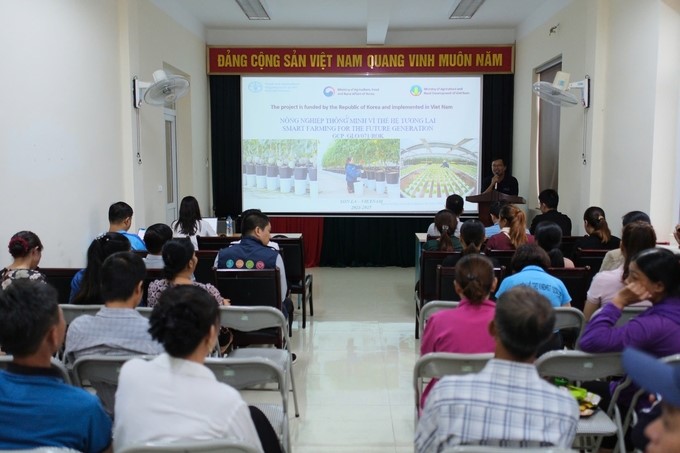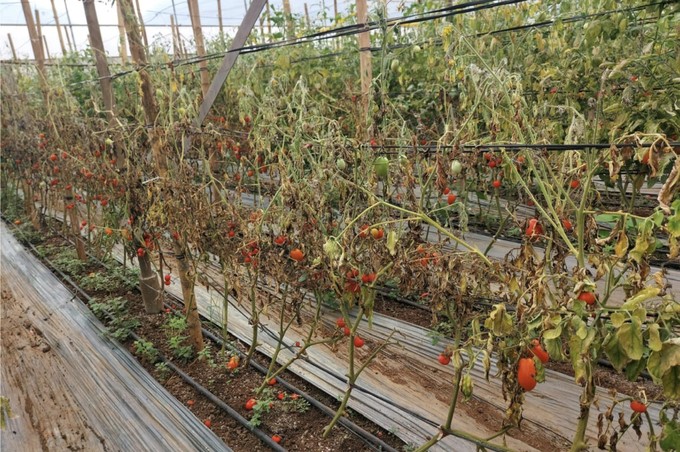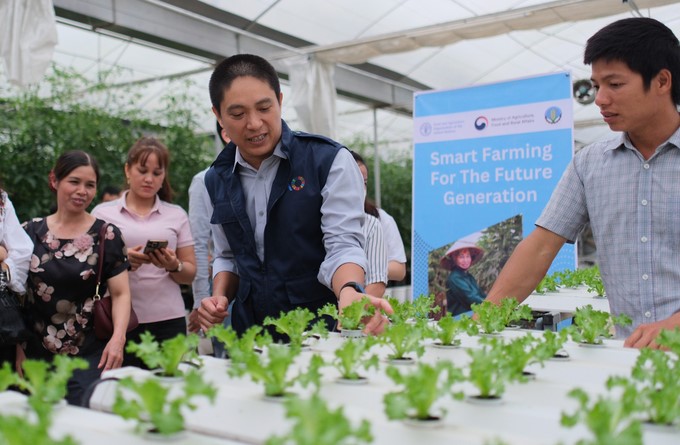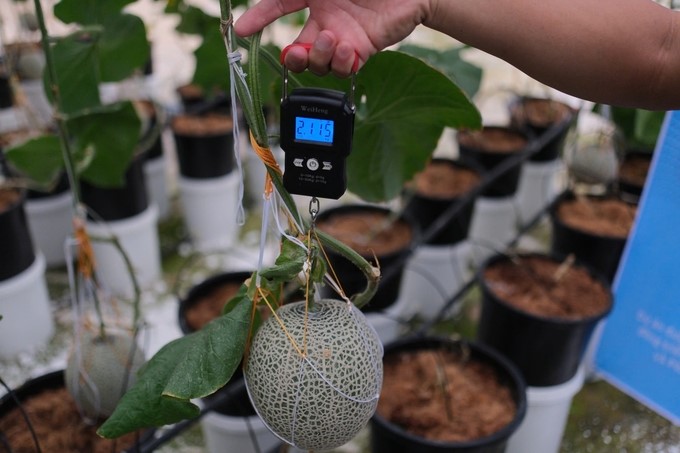Soilless vegetable production technology opens new opportunities for Moc Chau
(VAN) On August 30, in Moc Chau, the Food and Agriculture Organization of the United Nations (FAO) hosted a training workshop on vegetable production in greenhouses using substrates and hydroponics.

Training workshop on greenhouse vegetable production using substrates and hydroponics organized by FAO in Moc Chau, Son La. Photo: Quynh Chi.
Risk of vegetable diseases in Moc Chau
The “Smart Agriculture for Future Generations” project, funded by the Korean Government through FAO and approved by the Son La Provincial People's Committee, is implemented by the Fruit and Vegetable Research Institute (Ministry of Agriculture and Rural Development). The project supports 34 farming households and nursery owners in Moc Chau district (Son La) to renovate and optimize existing greenhouses and provides high-quality seedlings, fertilizers, and agricultural technical tools to participating households. The main crops grown under the project include tomatoes, melons, cucumbers, cantaloupes, and bell peppers.
However, vegetable growers in Moc Chau, particularly those using project-supported greenhouses, face significant challenges, notably the risk of soil-borne diseases. Bacteria and nematodes are especially problematic, as they are difficult to control with no effective treatment available, even chemical options.
As a result, many households have had to switch to lower-value crops that are still susceptible to similar diseases.
Ms. Ha Thi Tuoi, from Muong Village, Phieng Luong Commune (Moc Chau District), who received technical support and a greenhouse for tomato cultivation through the project, shared her experience: “Insects devour the leaves and then attack the fruit. I’ve sprayed many types of pesticides, but none worked. Every year, my garden suffers from butterfly infestations, especially during the rainy season when the moist soil fosters insect growth and development.”
Last year, Mrs. Tuoi's family experienced a poor harvest, and this year's yield remains low. Although her tomato plants produced a large quantity, the fruits were small and substandard, with 7-8 tomatoes weighing 1kg, compared to neighboring households where only five tomatoes weighed the same.

Tomato garden in Moc Chau, Son La damaged by disease in August 2024. Photo: FAO.
FAO experts advise that to tackle soil-borne diseases, farmers need to improve control over all stages of production, from seedling nurseries to effective greenhouse management. Greenhouses should be equipped with insect-proof nets and doors to prevent diseases from entering. Proper fertilization, watering, and pruning are also essential for optimal plant growth.
Vegetable production technology using substrate and hydroponics
When soil is contaminated and unsuitable for cultivation, soilless growing technologies using substrate, such as coconut fiber bags, and hydroponics offer a viable solution. These methods can help increase economic value and efficiency for households with greenhouses. However, they require a high level of knowledge and production skills.
On August 30, FAO organized a field trip for representatives of the 34 households participating in the project to a 1,600m² greenhouse at the Moc Chau High-Tech Agriculture Application Center. Three models were demonstrated: one for growing melons, one for growing tomatoes using coconut fiber substrate, and one for growing hydroponic lettuce. This allowed farmers to directly observe the technical process of producing vegetables using soilless technology, helping them better understand advanced agricultural techniques and providing opportunities to increase productivity in vegetable cultivation.
According to Dr. Ta The Hung, a hydroponics expert at FAO Vietnam, hydroponic technology is well-suited for producing leafy vegetables such as lettuce and mustard greens. This method allows plants to absorb nutrients efficiently, conserves water and space, and enhances both productivity and product quality.
Additionally, the technology of using substrate for growing vegetables is an advanced method applied in the production of fruiting vegetables like tomatoes, melons, cucumbers, and bell peppers. This approach not only optimizes the growing process but also provides better control over factors that influence plant growth.

Hydroponic vegetable growing model in a greenhouse at Moc Chau High-Tech Agricultural Application Center. Photo: Quynh Chi.
Coconut fiber substrate is a key component in the beef tomato growing model at the Moc Chau High-Tech Agricultural Application Center. This substrate is known for its excellent water retention and high drainage capacity. However, because coconut fiber decomposes easily, it is often mixed at a ratio of 70% fiber to 30% peat to enhance durability and effectiveness throughout the growing process.
In addition to adopting advanced technologies, households participating in the project are encouraged to implement several disease prevention measures to ensure quality and productivity. Using heat-treated substrate and adding Trichoderma products helps limit the growth of pathogens. Additionally, planting high-quality varieties or grafted plants is an effective preventive measure. For disease prevention using pesticides, specific products such as Nimitz 480EC (Israel), Velum Prime 400SC (Bayer, Germany), and AT Padave (biological pesticides) can be used to combat nematodes. Copper-containing products like Mancozeb and Ridomil and active ingredients like Thiamethoxam and Dimethomorph are highly effective against fungal diseases, particularly downy mildew.
Positive response from farmers
The effectiveness of the soil-free crop production model has been practically demonstrated at the Moc Chau High-Tech Agricultural Application Center. Notably, Fujisawa RZ melons, a high-value crop, showed impressive results in the FAO pilot model, averaging 1.7 kg per fruit, with many melons weighing over 2 kg.
Many farmers have expressed appreciation for the outstanding benefits of this soil-free growing technique, from reducing the risk of pests and diseases to optimizing resource use, such as water and nutrients. The method results in uniform plant growth, high productivity, and significantly improved product quality compared to traditional soil-based farming methods.
This model not only helps farmers reduce pesticide costs but also minimizes environmental impacts, promoting more sustainable agriculture practices. The positive feedback further confirms that the soil-free planting model is the right approach, opening up new opportunities for high-tech agriculture in Moc Chau and surrounding areas.

Melons grown in FAO's pilot greenhouse weigh over 2 kg and brix 15%. Photo: Quynh Chi.
According to Expert Le Nhu Thinh from the Institute of Vegetable and Fruit Research, many establishments in Lam Dong and Ho Chi Minh City have widely adopted hydroponic technology due to its advantage of reducing plants' susceptibility to external factors. In Moc Chau, while cultivating vegetables and fruits has seen significant growth recently, this is the first time a hydroponic production model has been piloted locally.
"Through the implementation of this model, the project aims to provide farmers with a comprehensive understanding of their role in the fruit and vegetable production process," said Mr. Thinh. "Currently, most households in Moc Chau still primarily grow crops in soil, with only a small number adopting substrate or hydroponic methods. This pilot model introduces a new direction, helping households appreciate the importance of scientific and technological advancements and gradually equip themselves with the knowledge needed to access the market when the opportunity arises."
Although hydroponic models require higher initial investment costs compared to traditional soil-based farming, and many consumers still prefer soil-grown products, this approach shows great promise. As market demand grows for high-quality products with stable pricing, high-tech vegetable and fruit growing methods like hydroponics are well-positioned to meet these requirements, thus opening up opportunities to enhance the value and competitiveness of agricultural products.
vietnamagriculture.nongnghiep.vn
Older news items:
- Vietnam's lychee farmers bemoan slumping prices - 07/07/2020 03:19
- Vietnam seeks to export fresh fruits, vegetables to Thailand - 15/05/2020 04:07
- Bac Giang: More lychee to be grown for export to Japan - 14/05/2020 08:20
- Dragonfruit: The next potential major tropical fruit? - 07/11/2019 03:12
- TFNet organizes the 2019 International Symposium on Tropical Fruits in Vietnam - 07/11/2019 02:43